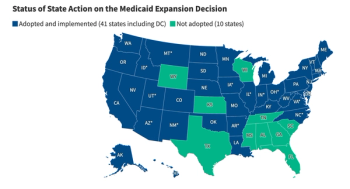
How to save Medicaid
In 2011, Medicaid financed care for 70 million people at a cost of $432 billion. Broader eligibility requirements are expected to bring another 16 million into the pool.
Key Points
Demands on Medicaid have grown in recent years. In 2011, Medicaid financed care for 70 million people at a cost of $432 billion, according to government reports. Broader eligibility requirements written into the Patient Protection and Affordable Care Act (PPACA) are expected to bring another 16 million into the pool. To offset costs for struggling state budgets, the federal government will fully finance new enrollees in 2014, gradually reducing its contribution over time.
The federal government's share of Medicaid spending is expected to reach $4.4 trillion over the next decade, and overall spending as a percentage of the national economy is projected to grow by 35%, according to Congress.
While the program is faced with financial and operational obstacles in many states, health policy experts believe there are solutions. Experts disagree about the breadth or depth of changes that need to occur to cut costs, increase operational efficiencies and improve quality of care, however, they do agree that something must be done.
About 70% of all Medicaid enrollees receive some or all of their services through managed care. The Kaiser Family Foundation (KFF) reports that more than 26 million Medicaid beneficiaries are enrolled in managed care. However, this segment of the Medicaid population isn't responsible for the highest costs. In 2007, managed care spending only represented about 20% of total Medicaid spending for services, according to KFF.
This discrepancy is largely due to the demographics of the Medicaid population receiving managed care services-mostly children and families. Health policy experts cite the most costly segment of the Medicaid population-the elderly and disabled-as underrepresented in managed care.
Many states have adopted managed care options to help provide services for their growing Medicaid populations. According to the Kaiser Commission on Medicaid and the Uninsured, 47 states were operating comprehensive Medicaid managed care programs in the fall of 2010. States have long been turning to managed care to provide healthcare for children, pregnant women and parents, but recently many have begun adopting managed care programs for the more costly Medicaid enrollees as well.
In February 2012, Kaiser reported that half of the states now enroll their dual eligible population in managed care programs for some or all of their Medicaid services. The enrollment can be voluntary or mandatory depending on the state.
Texas plans to mandate that 1.1 million of the remaining 3.3 million Medicaid beneficiaries on fee-for-service programs receive managed care instead, according to the commission, and California also has plans to move up to 400,000 seniors and people with disabilities into managed care.
The Association for Community Affiliated Plans (ACAP) supports these efforts and believes that providing managed care services for the dual-eligible population will significantly reduce the cost to care for this segment of the population and close gaps in care between Medicaid and Medicare.
"We hope that more states follow this trend and hope that this leads to a more permanent structure of care for dual eligibles," says Margaret A. Murray, chief executive officer of ACAP.
She believes managed care is an ideal fit for people receiving supplemental security income since the aged, blind and disabled segment of the population has high per-member per-month costs in categories where managed care organizations could make an impact, such as ER use, hospitalizations, pharmacy utilization and uncontrolled chronic conditions that might need care management.
Moving more of the population segment into managed care could also translate into significant cost savings. One study sponsored by ACAP in 2008 estimates that moving dual eligibles into a capitated setting could yield savings of about 3% each year. Duals accounted for 36% of all Medicare spending and 39% of Medicaid spending, according to ACAP.
"There's certainly a large revenue stream to provide the administrative economies of scale that you need," Murray says.
ACAP recently made a policy recommendation for a new state plan option featuring a fully integrated, capitated model of care that states could choose within the Medicaid state plan. Under its model, states would contract with managed care organizations to provide care for the dual eligible population, and CMS would set standards for patient protections.
According to Murray, the option would provide states with a more permanent program instead of relying on Medicare Special Needs Plans or limited demonstration projects. She says the opportunity for savings through more managed care is a win for patients, too.
But not everyone views capitation for the high-need population as a panacea.
"It makes absolute sense to integrate care for everyone, and especially for people with complex and chronic needs. It’s high time we move past the demonstration projects, but we can't expect significant savings until we fully embrace comprehensive delivery reform and normalize payments across all systems of care," says Georganne Chapin, president and chief executive officer of Hudson Health Plan in Tarrytown, N.Y.
Newsletter
Get the latest industry news, event updates, and more from Managed healthcare Executive.





















































